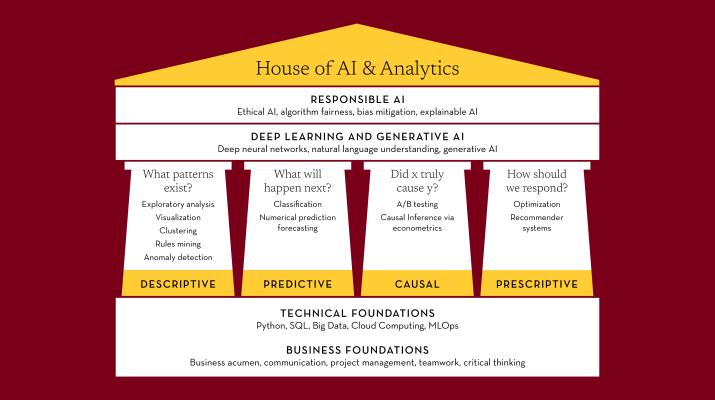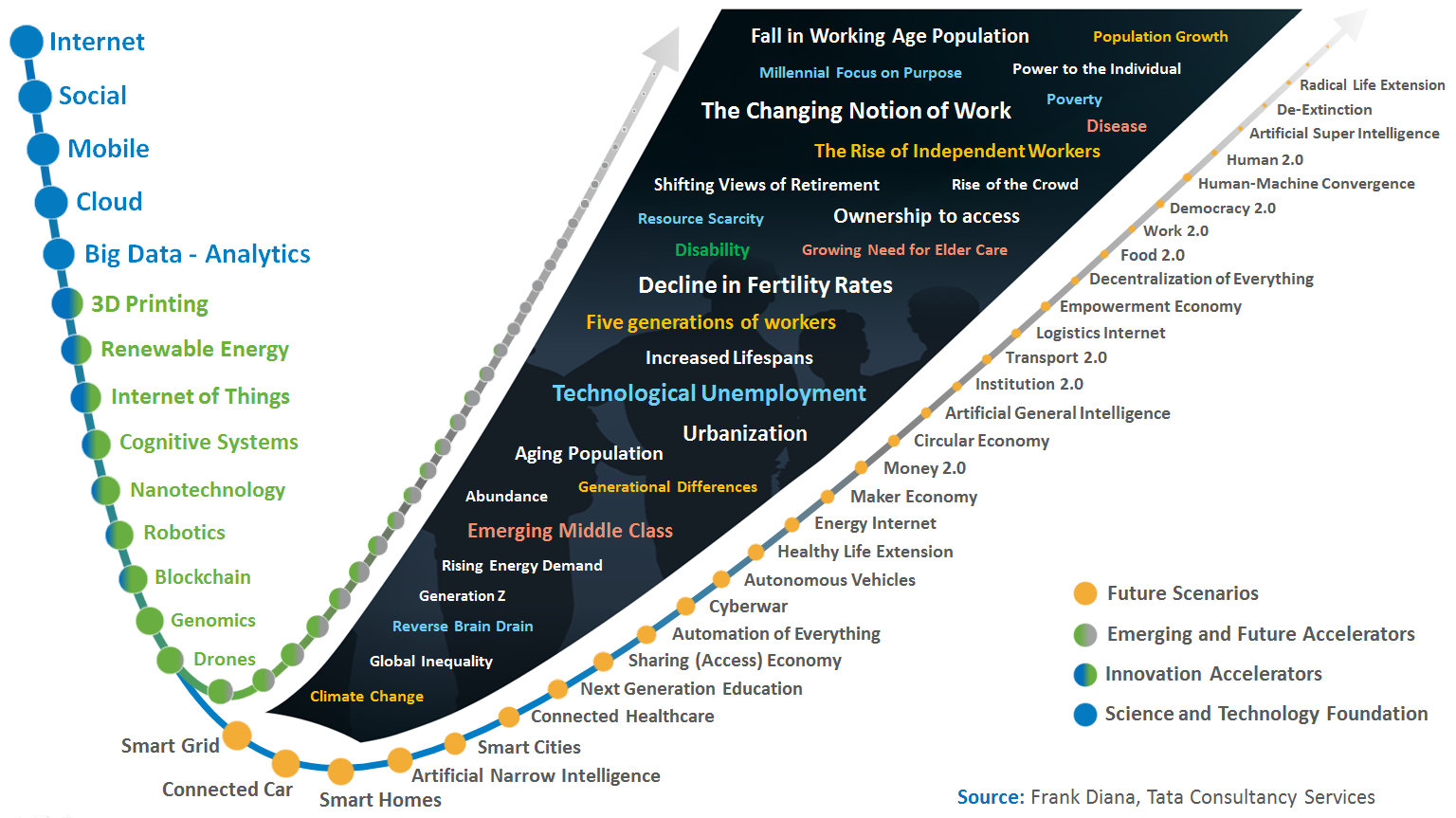
What is business analytics and why is it important?
Thursday, June 6, 2024
Carlson School Graduate Programs
Find Your Master's DegreeResources for Prospective Graduate StudentsCompanies today generate several hundred thousand gigabytes of data each minute. All this data must be prepared and analyzed before it becomes information businesses can use. This process is called business analytics and has become a critical tool for companies seeking to thrive in today’s highly competitive economy.
In this post, you’ll learn about business analytics’ significance, its evolution, future trends, and what it means for you.
What is business analytics?
Business analytics is the process of using data to gain insight and inform future business decisions and plans. We can think of analytics as a house as seen in the House of AI and Analytics framework below.
There are four pillars of analytics. These are built upon a solid foundation of business skills, such as communication, project management, teamwork, critical thinking, and business acumen, as well as technical data engineering skills, including Python, SQL, big data, cloud computing, and MLOps.
The four pillars of analytics are:
- Descriptive - Uses historical data to identify what happened
- Predictive - Uses historical data to understand what will happen next
- Causal - Uses data to determine if x truly caused y
- Prescriptive - Builds upon descriptive, diagnostic, and predictive analysis to suggest decisions or actions
Within each type of analytics are various methods and techniques, such as anomaly detection (descriptive analytics), classification (predictive analytics), A/B testing (casual analytics), and optimization (prescriptive analytics). These techniques help reveal insights that businesses can apply towards their objectives.
Artificial intelligence is built upon the four pillars. This House of AI and Analytics framework is how the Carlson School’s Master’s of Science in Business Analytics program is structured.
(Want to learn more about AI and analytics? Get 5 artificial intelligence myths debunked with Carlson's resident AI scholar, Dr. Ravi Bapna.)
Why is business analytics important?
Business analytics can empower organizations across industries and functions to make data-informed decisions.
Here are some case studies to illustrate its uses:
1. Build Wealth MN: improving client experience
Build Wealth MN, a nonprofit, wanted to understand how different client characteristics and program activities lead to successful outcomes for those in their Family Stabilization Plan. Using various analytics tools and methods, participants were segmented into groups according to the needs they may have. Participant dropout points were also identified. This analysis helped Build Wealth MN refine its program to improve outcomes, and secure grants and other funding.
Students in the Carlson School’s business analytics master’s program consulted on this project through the Carlson Analytics Lab.
Read about other experiential learning projects that our masters of business analytics students undertake:
2. Walmart: supply chain and inventory management optimization
Walmart used analytics to assist their inventory management during the holiday shopping season. They used historical data and predictive analytics to determine where and when to place holiday items along their supply chain. The retailer could meet customer demand for various products throughout the season both online and in stores. This helps increase sales and reduce waste.
3. John Deere: preventive maintenance
John Deere collects real-time data on its machines daily. They track locations, use time, fuel consumption, and other metrics. When a machine fails, advanced analytics tools are used to detect matching patterns in other machines so preventive measures can take place. The company can repair machines (often remotely) before greater issues arise. Not only does John Deere save on warranty costs and trips, but their clients also save on downtime costs.
Across industries, from manufacturing and retail to healthcare and finance, companies are using big data analytics to:
- Create personalized e-commerce journeys and marketing campaigns
- Improve process efficiencies and allocate resources
- Optimize sales
- Develop new products and services
- Detect fraud
There are many more capabilities being used and that are emerging. Before we get to the future of analytics, let’s review how we got here.
The evolution of business analytics
In the late 1800s, Frederick W. Taylor introduced the System of Scientific Management. This early form of analytics focused narrowly on improving production. Namely, its efficiencies, quantities, and cost-effectiveness.
The field rapidly matured and grew in prominence with the introduction of computers. As information technology advanced, it also revolutionized the field each time by making it possible to process larger and larger amounts of data.
Here’s a quick timeline of major tech innovations and their impact on the field:
- 1940s–1960s: Mainframes - Basic “tabulating machines” that process data recorded on punch cards.
- 1980s–1990s: Client-server, Microsoft Excel, relational databases, data warehouses - Data was still clunky to work with. It needed to be stored in physical locations and was limited by memory space.
- 1990s–2005: Internet, non-relational databases (NoSQL) - Customers were brought online and big data emerged. Data mining became a way to discover patterns within large datasets.
- 2005–2015: Social media, cloud computing, Google Analytics - Cloud computing enabled businesses to flexibly store data in remote locations that can be accessed simultaneously. Businesses could use insights efficiently gathered from large amounts of data to inform business decisions.
- 2015–today: Internet of things, data platforms - Data scientists and analytics professionals use advanced technology to turn trillions of collected data into actionable insights.
As technology continues transforming our society, business analytics is no longer a “nice to have.” Like marketing and supply chain, it’s a core pillar of business today. And like other business functions, it continues to evolve. So where’s the field headed?
The future of business analytics
Companies continue to invest aggressively in data and analytics. The emergence of ChatGPT has sparked interest in the next evolution of analytics, specifically generative artificial intelligence (AI). For example, investments in artificial intelligence are expected to surpass $300 billion in 2026 globally.
While generative AI has dominated mainstream conversations, broader forms of AI like machine learning (e.g. what Netflix’s recommendation algorithm runs on) and other technologies are likely to create greater impact on business practices and decisions in the immediate future.
This visual illustration presents a snapshot of existing and predicted technologies over time.
- Blue dots represent developed and maturing tech that businesses are already using, such as the internet, cloud computing, and big data analytics.
- Green dots represent technologies that are being developed or already exist but have yet to be fully incorporated into society or seen full application. This includes things like 3D printing, Internet of Things, robotics, and blockchain.
- Yellow dots represent future technologies and scenarios that aren’t yet here or are a prediction of what will be developed. This includes concepts like the smart home, artificial narrow intelligence, etc.
- The grayed middle section represents social phenomena that may impact future technological scenarios, such as climate change and increased life expectancy.
Regardless of what technologies do and don’t develop, it’s clear that the massive amounts of data they generate present a challenge for businesses. Data governance, data management, and data security are critical to taking full advantage of its uses. This means data can’t just be viewed as an aid to decision-making. It needs to be recognized as a valuable asset.
As organizations strive to become more data-driven, what does this mean for employers and the talent they seek?
Growing demand for business analysts
As a relatively new career, there’s a shortage of business analytics talent despite its rapidly growing demand. The U.S. Bureau of Labor Statistics projects an average of 17,770 data analysts/data scientists are needed each year for the next decade.
Some industries have already made huge investments in data analytics, including telecommunications, insurance, advertising, financial services, healthcare, and technology. Needs for data professionals range across business functions from sales and human resources to business development and customer service.
Some crucial skills and knowledge you’d need include:
- Business acumen - an understanding of the greater business context to identify issues and apply insights
- Data analysis - a solid foundation in topics like statistics, programming, and data engineering, and advanced techniques like predictive AI modeling to solve problems and quickly adopt new tools
- Communication - the ability to present analysis and insights to various audiences and stakeholders
- Responsible data usage - an understanding of privacy, fairness, and equity issues so ethical concerns can be addressed
If you’re interested in pursuing business analytics or a career in a related field, but unsure where to start, try taking a course or earning a certification. For more comprehensive training, consider completing a master’s degree in business analytics.
The Carlson School’s Master of Science in Business Analytics curriculum will equip you with a systematic understanding of the field and a robust set of essential skills in one year. You’ll learn business analytics fundamentals and advanced topics including AI. You can also take our Artificial Intelligence in Business track to build additional skills in this area.
Best of all, you’ll have opportunities to work with real-world datasets to solve problems for organizations through the Carlson Analytics Lab. With our comprehensive and experiential analytics curriculum, position yourself to thrive in the dynamic landscape of business analytics at any company, in any industry.



